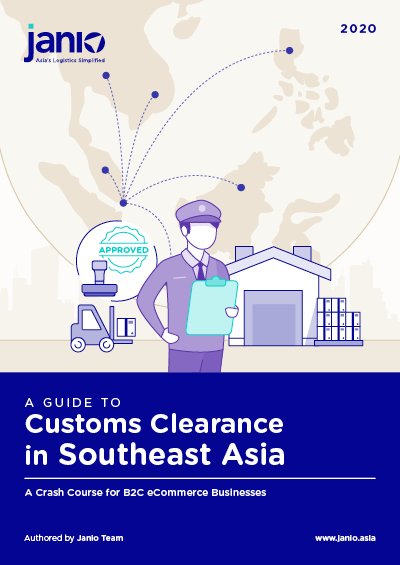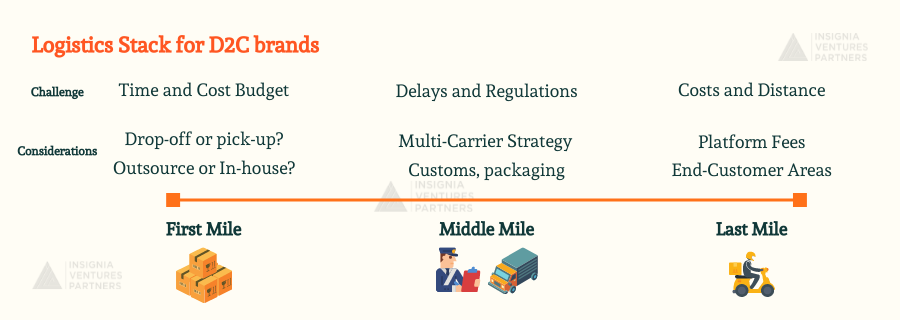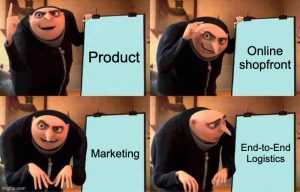Highlights
- As D2C brands, the main value proposition is to disrupt incumbents by understanding and responding to consumer needs better. Optimizing first mile logistics is all about balancing time (and costs) spent on customer acquisition and logistics.
- We note that sellers should nonetheless adopt a multicarrier strategy informed by both experience and the necessity of diversification.
- Where this is a highly-saturated market for logistics providers, ecommerce sellers are on the winning side as providers here compete mainly on price….For F&Bs, on platform merchants such as food delivery apps, we conversely can consider which platform charges the lowest platform fee.
Over the past weeks, we have traced the development of the Ecommerce Logistics stack. Our journey began with an overview on how the First Mile has become more sophisticated, catering to sellers of all sizes. Then we looked at the Middle Mile where aggregation of parcels allowed sending large volumes to different locations at incredible speeds. We lastly saw how parcel journeys within cities have become quicker and more efficient at the Last Mile segment.
Having traced the journey of our parcel, the ecommerce sellers in our midst are probably strategizing on actionable next steps. We’ve spoken to our portfolio companies in this space and are excited to now cap this series with a discussion on how online sellers can best optimise logistics stack for cheaper, faster, and more reliable deliveries.
Optimising the First Mile: Balancing time (and cost) allocation
A customer places her order on your online shopfront. After checking the order details, you excitedly pick three different items you neatly stashed away on a shelf, pack them into a sturdy box. Having fulfilled the several orders all by yourself, you’re ready to send it out to your nearest sorting centre. At the same time, you ponder if it’s worth paying extra to have your parcels picked up. On the other extreme end, you’re thinking of having the entire picking, packing, and send-off process entirely outsourced to a fulfilment centre. Your choice should involve a high level of volume and customisation you need- we here present you a matrix:
We first note that as an entrepreneur, spending your own time handling the actual logistics comes with high opportunity cost, especially if you have a highly-customised product which requires active research into latest trends, and a more bespoke manufacturing process.
It takes crucial time away from providing customer support, consumer/market research for product development, which invariably makes customer acquisition more expensive. As D2C brands, the main value proposition is to disrupt incumbents by understanding and responding to consumer needs better.
As an entrepreneur, you’ll be the best judge of this. If customer acquisition cost is high due to poor marketing-to-sales conversion or poor customer satisfaction, management time would be best spent on customer acquisition rather than logistics. After all, both Customer Acquisition (CM2) and Logistics (CM3) will eat into your Contribution Margin, but between the two, there is greater scope to reduce customer acquisition cost by directing targeted marketing and improving sales funnel than the potential cost-savings of running logistics in-house which is less-flexible. In this case you would be better off arranging for products picked up from your shop front rather than to make the trip to the distribution centre yourself.
On the more extreme end, if you have a highly customisable product that is flying off the shelves at great volume (such as if you’re putting your customer’s name on every single item), it’s probably time to reconsider which parts can be customised and how the process can be streamlined without affecting overall customer satisfaction. This is especially at a large scale where returns management becomes more crucial, where the more-customisable a product is, the greater returns and exchanges will cost you. Conversely at a high volume with a standardised ‘off the shelf’ product where any packer can literally pick it off the shelf and pack it into a box, you might want to consider outsourcing the entire process to both pack and send parcels off to a fulfilment centre like the many ones in the network of logistics platform Shipper in Indonesia.
Optimising the Middle Mile: Going Multicarrier
The middle mile involves the aggregation of many parcels at sorting centres, as we have previously described, where they are sent off on their journey. When a seller sends a parcel off at each Logistics Provider’s sorting centre, the company then works with different middle-mile partners from trucking companies to air freight.
Where we do not get to choose these middle-mile partners, it may seem on the surface that there is little actionable insight to optimise this mile. On one end, you could try to experiment with different providers and learn from previous deliveries about the overall efficiency of each carrier, but every route is different. As you get different orders from each part of the country or region, the best carrier from Jakarta to Bali might not be as efficient as sending to Bandung.
Nonetheless, we note that sellers should nonetheless adopt a multicarrier strategy informed by both experience and the necessity of diversification. Even major global eCommerce platforms use several carriers, choosing not to put their entire parcel volumes in just one basket. A tech-enabled solution would be to use a Fourth Party Logistics provider (4PL) like Janio. 4PLs serve a plethora of online sellers from large ecommerce platforms to D2C sellers, and continually receives new cohorts of data across different combinations of origins and destinations.
 Where most delays on the ecommerce logistics stack occur in the middle mile, there are ways to mitigate this and ensure quick and reliable processing. One way that Janio identified is to ensure that shipments are packaged with durable materials. This not only ensures that the parcel’s contents reach your customer safely, but also that your shipping label would be able to stick and indicate details such as the destination address correctly. It is also from my experience that faded or torn-off labels contribute to most delays in the middle mile, noting that the handling of parcels behind the scenes is not an entirely gentle process.
Where most delays on the ecommerce logistics stack occur in the middle mile, there are ways to mitigate this and ensure quick and reliable processing. One way that Janio identified is to ensure that shipments are packaged with durable materials. This not only ensures that the parcel’s contents reach your customer safely, but also that your shipping label would be able to stick and indicate details such as the destination address correctly. It is also from my experience that faded or torn-off labels contribute to most delays in the middle mile, noting that the handling of parcels behind the scenes is not an entirely gentle process.
Check out the many guides Janio has on shipping to various markets in Southeast Asia >>>
Lastly it is always smart to ensure that you have researched relevant laws and provisions- some carriers do not accept foodstuff, and shipping alcohol usually is subject to different rules, if allowed at all. In any case, cross-border shipping requires certain declarations such as the value of goods, where you may be subjected to tax. Filing these incorrectly not only leads to delays, hampering customer satisfaction, but could also put you liable for legal action.
Optimizing the Last Mile: Getting the Best Price
Finally, we shed light on the last mile, where the parcel marks the final journey to your customer’s doorstep. We have previously noted that most ecommerce delivery originates and ends in the same city, giving rise to point-to-point delivery networks within cities. When buying online, we often choose sellers who ship out from as close to us as possible. This is most prominently felt in food deliveries. The good news is that an ultra-rapid network of high-speed high-volume deliveries within cities that are already highly matured, being the first to develop amongst our ecommerce logistics value chain.
Where this is a highly-saturated market for logistics providers, ecommerce sellers are on the winning side as providers here compete mainly on price. We have seen players launch promotions such as rewards programmes, referral codes to other sellers, and even weight-agnostic flat rates based fixed parcel sizes. Fixed parcel sizes provided for free can also help offset costs.
For our F&B friends on platform merchants such as food delivery apps, we conversely can consider which platform charges the lowest platform fee. Equally important, considering 70% of online product discovery in SEA happens on marketplaces and platforms, is the exposure it provides, which is tied to the number of active users on the platform.
Still a long way from Amazon-level logistics, but never a better time to ride the ecommerce boom!
It has never been a better time to be an ecommerce seller. The past five years have truly set the scene in enabling the logistics backbone of our region, ready to welcome the new normal of online ecommerce. As internet penetration in ASEAN exceeded 80% for the first time in 2020, consumers are increasingly beginning to shop online, and are demanding instant deliveries, great customer service, as well as highly-customised products. We hope this guide is useful in building your “Amazon-style” logistics stack!
Russell is excited about the power of innovation improving lives across Southeast Asia. An ex-founder from the London McKinsey Venture Academy, Russell is now looking for daring new founders in Southeast Asia. Drop your pitch at russell@insignia.vc.


